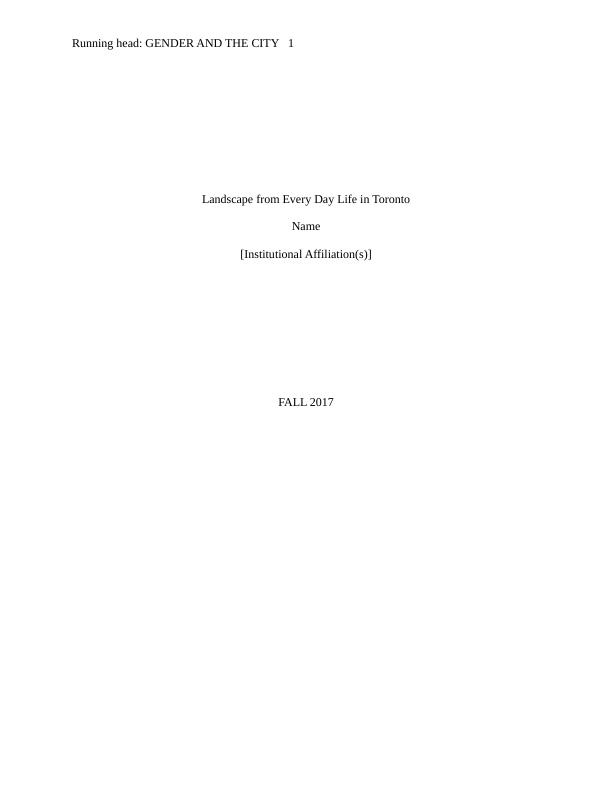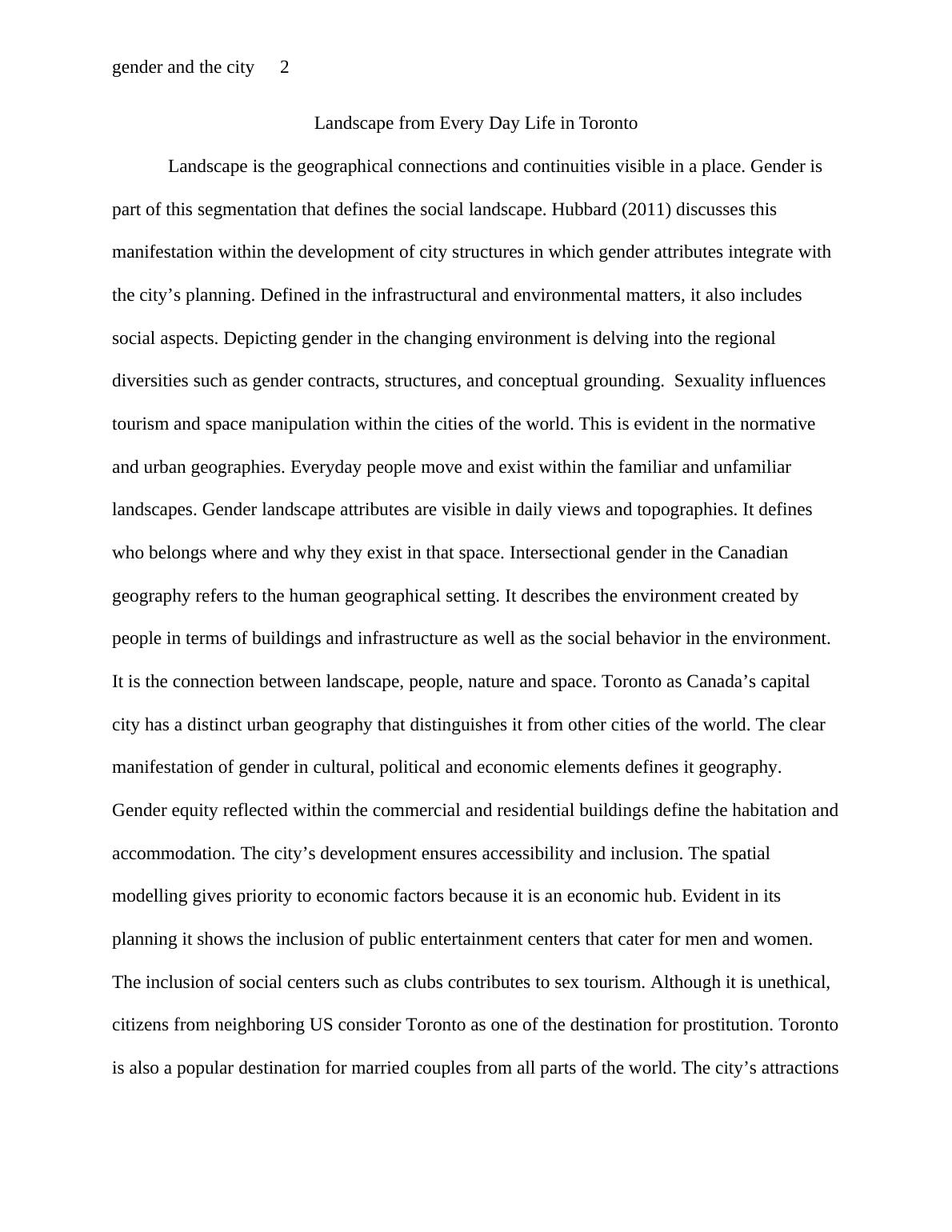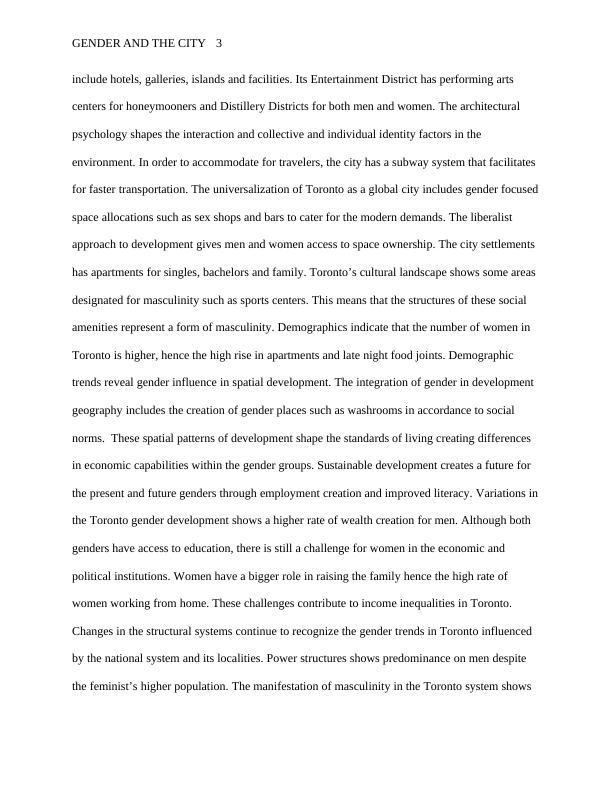(solved) Gender and the City PDF
Added on 2020-03-28
9 Pages2235 Words279 Views
Running head: GENDER AND THE CITY1Landscape from Every Day Life in TorontoName[Institutional Affiliation(s)]FALL 2017

GENDER AND THE CITY2Landscape from Every Day Life in TorontoLandscape is the geographical connections and continuities visible in a place. Gender is part of this segmentation that defines the social landscape. Hubbard (2011) discusses this manifestation within the development of city structures in which gender attributes integrate with the city’s planning. Defined in the infrastructural and environmental matters, it also includes social aspects. Depicting gender in the changing environment is delving into the regional diversities such as gender contracts, structures, and conceptual grounding. Sexuality influences tourism and space manipulation within the cities of the world. This is evident in the normative and urban geographies. Everyday people move and exist within the familiar and unfamiliar landscapes. Gender landscape attributes are visible in daily views and topographies. It defines who belongs where and why they exist in that space. Intersectional gender in the Canadian geography refers to the human geographical setting. It describes the environment created by people in terms of buildings and infrastructure as well as the social behavior in the environment. It is the connection between landscape, people, nature and space. Toronto as Canada’s capital city has a distinct urban geography that distinguishes it from other cities of the world. The clear manifestation of gender in cultural, political and economic elements defines it geography. Gender equity reflected within the commercial and residential buildings define the habitation andaccommodation. The city’s development ensures accessibility and inclusion. The spatial modelling gives priority to economic factors because it is an economic hub. Evident in its planning it shows the inclusion of public entertainment centers that cater for men and women. The inclusion of social centers such as clubs contributes to sex tourism. Although it is unethical, citizens from neighboring US consider Toronto as one of the destination for prostitution. Torontois also a popular destination for married couples from all parts of the world. The city’s attractions

GENDER AND THE CITY3include hotels, galleries, islands and facilities. Its Entertainment District has performing arts centers for honeymooners and Distillery Districts for both men and women. The architectural psychology shapes the interaction and collective and individual identity factors in the environment. In order to accommodate for travelers, the city has a subway system that facilitates for faster transportation. The universalization of Toronto as a global city includes gender focusedspace allocations such as sex shops and bars to cater for the modern demands. The liberalist approach to development gives men and women access to space ownership. The city settlements has apartments for singles, bachelors and family. Toronto’s cultural landscape shows some areas designated for masculinity such as sports centers. This means that the structures of these social amenities represent a form of masculinity. Demographics indicate that the number of women in Toronto is higher, hence the high rise in apartments and late night food joints. Demographic trends reveal gender influence in spatial development. The integration of gender in development geography includes the creation of gender places such as washrooms in accordance to social norms. These spatial patterns of development shape the standards of living creating differences in economic capabilities within the gender groups. Sustainable development creates a future for the present and future genders through employment creation and improved literacy. Variations inthe Toronto gender development shows a higher rate of wealth creation for men. Although both genders have access to education, there is still a challenge for women in the economic and political institutions. Women have a bigger role in raising the family hence the high rate of women working from home. These challenges contribute to income inequalities in Toronto. Changes in the structural systems continue to recognize the gender trends in Toronto influenced by the national system and its localities. Power structures shows predominance on men despite the feminist’s higher population. The manifestation of masculinity in the Toronto system shows

End of preview
Want to access all the pages? Upload your documents or become a member.
